![]() Background |
Models |
Projects |
Publications |
People |
News
Background |
Models |
Projects |
Publications |
People |
News
![]() Background |
Models |
Projects |
Publications |
People |
News
Background |
Models |
Projects |
Publications |
People |
News
Model Overview
Algorithms hyperlinked
Source code hyperlinked
Model download
Other Open Source tools
Simply put, we simulate fully-integrated ecosystem dynamics in spatially variable landscapes - usually incorporating some component of the social drivers of the landscape dynamics, whether via water management rules or changes in land use policies.
The General Ecosystem Conceptual Model summarized within the Background: South Florida Landscape Conceptual Model section is the "starting point" for the quantitative formulation of the landscape simulation framework. For a conceptual description of the overall model framework, below we use the Everglades Landscape Model (ELM) as a primary example.
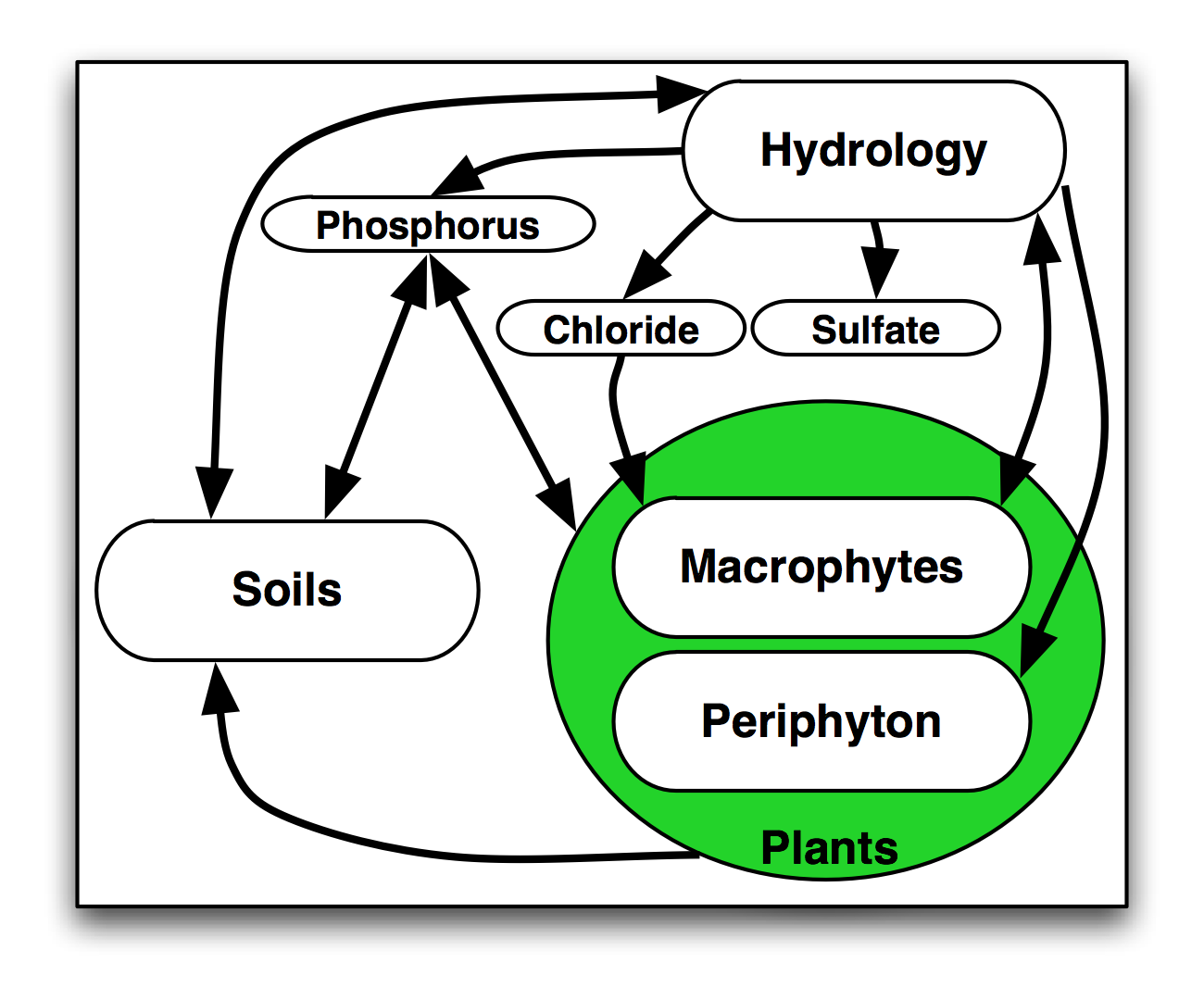 For this version of the Everglades Landscape Model (ELM), we explicitly integrate fully dynamic flux equations of hydrology, nutrients, plants, and soils within a hydro-ecological 'unit' model (referred to as the General Ecosystem Model, GEM, figure at left). We hypothesize that these capture the fundamental characteristics of habitats within the Everglades landscape: the dynamic ecological interactions among hydrology, biogeochemistry, and plant biology are critical to understanding and predicting changes within this ever-changing wetland system.
For this version of the Everglades Landscape Model (ELM), we explicitly integrate fully dynamic flux equations of hydrology, nutrients, plants, and soils within a hydro-ecological 'unit' model (referred to as the General Ecosystem Model, GEM, figure at left). We hypothesize that these capture the fundamental characteristics of habitats within the Everglades landscape: the dynamic ecological interactions among hydrology, biogeochemistry, and plant biology are critical to understanding and predicting changes within this ever-changing wetland system.
We sought to quantify the simplest set of ecosystem processes that are fundamental to changes in habitats, or assemblages of vegetation types. In some respects the modeled interactions are quite simplistic. Importantly, however, we made considerable effort to optimize the balance between realism, which tends to increase model complexity, and (the relative paucity of) supporting data/knowledge, which tends to 'scale-back' and simplify a model implementation. Within the 'unit' model, we assume that the dynamics occur within a homogenous spatial unit.
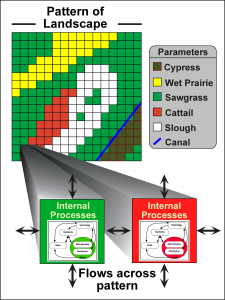 However, imperative to understanding landscapes such as the Everglades is the acknowledgement of spatial heterogeneity. In the ELM, ecosystem dynamics are made spatially-explicit by considering the flows and interactions across habitat types that are heterogeneously distributed across a regular model grid (figure on the left). The processes internal to grid cells can vary according to habitat type, each of which may have different hydro-ecological parameter sets. Flows of water and nutrients among grid cells are thus affected by changes within cells of the habitat mosaic, and this pattern can change over time as cumulative conditions in grid cells become more favorable for one habitat vs. another.
However, imperative to understanding landscapes such as the Everglades is the acknowledgement of spatial heterogeneity. In the ELM, ecosystem dynamics are made spatially-explicit by considering the flows and interactions across habitat types that are heterogeneously distributed across a regular model grid (figure on the left). The processes internal to grid cells can vary according to habitat type, each of which may have different hydro-ecological parameter sets. Flows of water and nutrients among grid cells are thus affected by changes within cells of the habitat mosaic, and this pattern can change over time as cumulative conditions in grid cells become more favorable for one habitat vs. another.
While the 'unit' model dynamics are relatively simple approximations of ecosystems, model complexity arises in its application as a distributed hydro-ecological simulation. The ELM hydrologic processes are relatively simple in their details, with the model simulating the primary hydrologic 'drivers' of the Everglades wetlands.
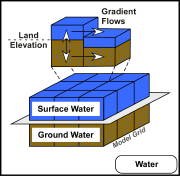 Hydrology is a primary driver of the Everglades. The ELM incorporates both overland and subsurface groundwater flows, coupling the surface and ground water exchanges at each time step (figure on left).
Hydrology is a primary driver of the Everglades. The ELM incorporates both overland and subsurface groundwater flows, coupling the surface and ground water exchanges at each time step (figure on left).
Moreover, managed flows through water control structures drive much of the hydrology in systems such as the Everglades. These managed flows transport water and nutrients through the network of canals and levees, explicitly simulated in ELM via interactions between raster grid cells and canal/levee vectors. These managed flows have major impacts on the spatial pattern of nutrient loads and distribution - and thus the ecology of the landscape.
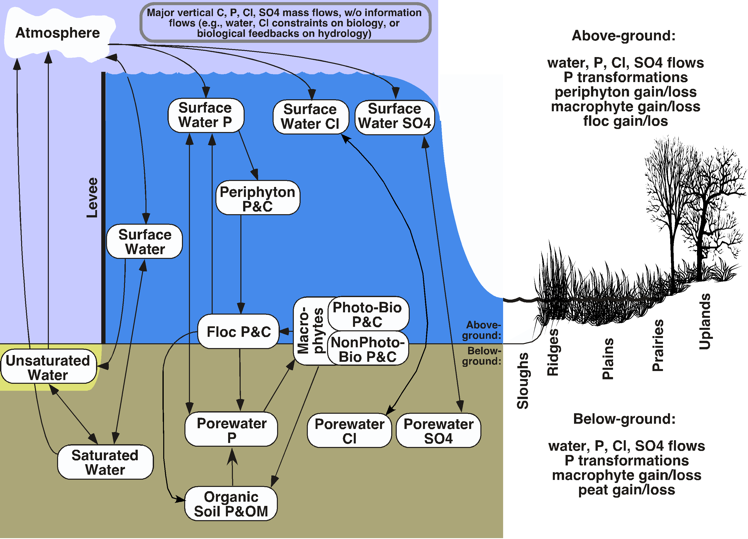
The details of the 'unit' model of the ELM. State variables are in oval boxes, linked by the major flow pathways among those variables. Abbreviations: P = Phosphorus; Cl = Chloride; SO4 - Sulfate; C = Carbon; OM = Organic Matter; Photo-Bio = Photosynthetic Biomass of macrophytes; NonPhoto-Bio = NonPhotosynthetic Biomass of macrophytes; Floc = Flocculent layer on/above soil.
The simple overview of ecosystem interactions is further detailed in the above figure showing all of the major state variables in the model. These dynamic interactions can be split into those occurring above-ground and below-ground, with the same code (but different parameter sets) used in all habitat types distributed through the landscape, from sloughs to forested uplands.
The next section on Models: Algorithms describes - graphically and mathematically - the interactions among these physical, chemical, and biological modules containing the different state variables. These include the 'vertical' solutions (of evapotranspiration, plant growth) and 'horizontal' solutions of the spatial flows that affect these variables.
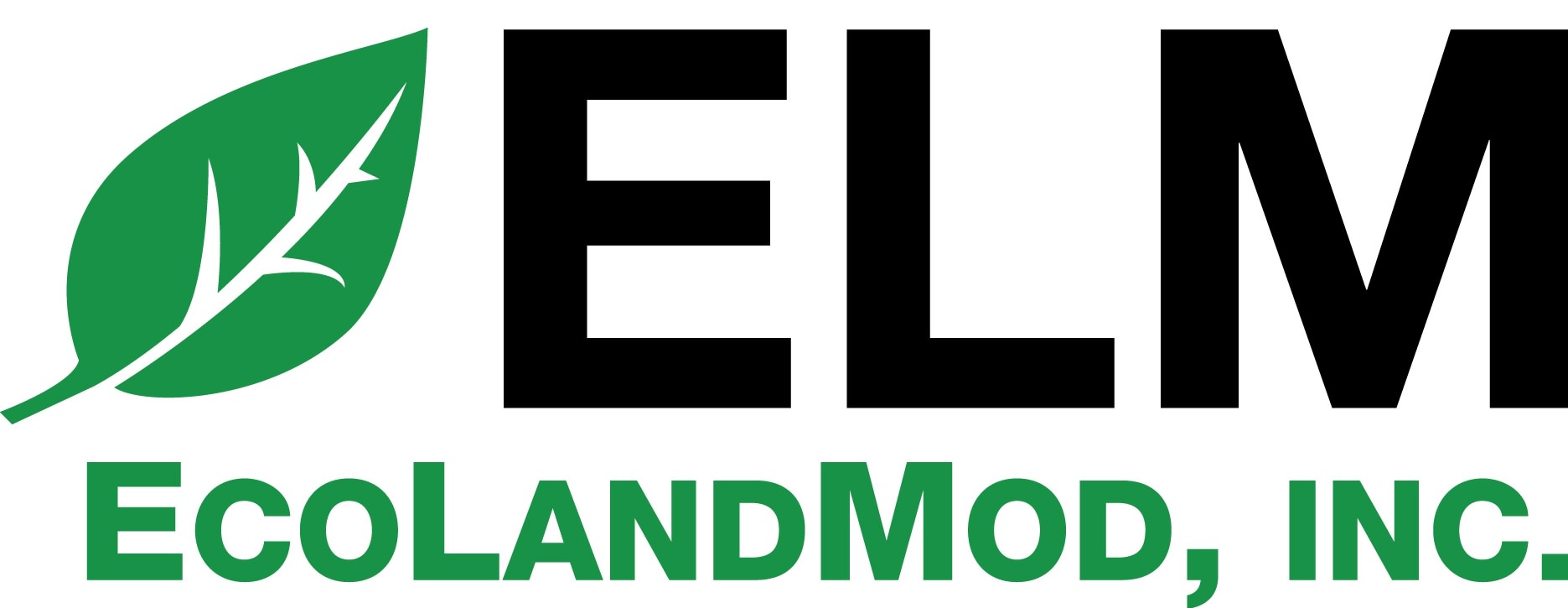 EcoLandMod Models
EcoLandMod Models